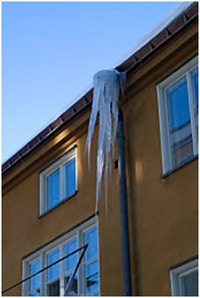ICICLES

Icicles on the ceiling is formed when snow and ice melt on the roof even though the air at have a temperature below zero degrees.
Causes:
- The most common reason for icicles is midday thaw, ie The sun is shining on the roof and melts snow and ice, despite below freezing in the air, melting water flows to the gutter and then to the drainpipe. Since the house front is shaded by surrounding buildings the melt water freezes in the drainpipes.
- Heat Leak due to changed conditions in the house use, wind facilities are increasingly used as dwellings and offices to better utilize the buildings spaces. This does, however, that the original roof with a cool wind and the roof insulation is replaced with a ventilated compartment closest roof with an underlying insulation is minimized to give the maximum ceiling height.
- Ventilation emissions from units located on the roof & heat-generating machines that radiates heat to the ceiling.
Problems:
Icicles as they fall to the ground may cause damage to people and property.
Frost on dewatering system such as gutters and pipes destroyed by frost blasting, due to melt water freezes in gutters and pipes which are not heated by the above reasons.
Decay damage on bargeboards & facades as a result of melt water flooding gutters.
Decay damage on ceilings as a result of leaking roof cover panels/roofing felt in roof cornices, roof angles, skylights, etc.
| Velox Frost Protection of Tak – The only system with plug connection. You do not need electricians out there on the roof.
Easy installation. Electrical requirements for the connection of control cabinets to the distribution board and in some cases drawing of multi-cable from the power distribution box in the attic. |

The solution of the problem:
- At midday thaw one must ensure that melt water can find its way into a frostless sewer to allow melt water running out on the sidewalk is just a way to move the problem. At ejectors problems often occurs where an ice formation is formed blocking the ejector.
- Heat Leakage at increased use of attic spaces often provide the same symptoms as midday thaw and is handled in a consistent manner.
- At the ventilation emissions and heat-generating machinery one should ensure to prepare a drainage channel for the melt water on the roof so that no ice is formed on the roof between the melted surface and the dewatering system. Heating cable is fitted with protection channels of the roofs direction of fall that a free passage is prepared.
Installation:

When connected to the surfacewater the heating cable should run down at least one meter below ground level and at roof well with associated sewer (one should heat the sewer pipe down to 1m in a heated space where downdraught in the tube can cause freezing here too.)
Gutters is installed with self-limiting heating cable mechanically protected by stainless steel channels, the channel is fixed in the gutter with special clips.
At the fall of the drainpipe the heating cable is attached with a stainless roof hook and is then freely hanging down through the pipe.
At roof cesspool can heating cable be allowed to run down the then turn up to limit the number of connection points.
In the roof gutter / cornice with angles, it is important to install heating cable in the angle in order to avoid frost blasting. Here most oftenly 2-4 cable runs is installed in the centre of the gutter for dewatering, at angled profiles of the gutter also a run in every angle.
